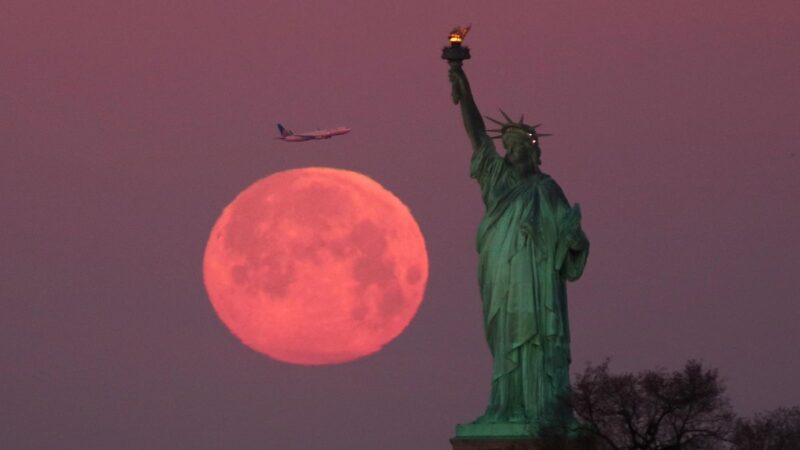The Super Snow Moon sets behind the Statue of Liberty as the sun rises on February 19, 2019, in New York City. (Photo by Gary Hershorn/Getty Images)
Corbis via Getty Images
What is a supermoon, and when is the next one? This week, on Wednesday, Nov. 5, the moon will turn full. November’s full moon rises in the east during dusk, shines all night long and sets in the west during dawn. That’s the way of things — and it happens every 29.53 days.
But there’s something different about the full Beaver Moon — it will appear to be slightly bigger and brighter than usual.
Here’s everything you need to know about the biggest and closest full moon of the year and why it’s rather special.
What Is A Supermoon?
It’s a full moon that’s slightly closer to Earth than usual. Astronomers tend to detest the term — and the public’s use of it — but supermoons (officially called perigee full moons, but typically full moon supermoons) have consequences for the natural world.
The moon’s orbital path around Earth is a slight ellipse; every month, there’s a near-point (perigee) and a far-point (apogee). The distance to the moon from Earth’s center changes from 406,000 km at apogee to about 357,000 km at perigee. Consequently, at perigee, the moon appears to be larger in the sky than its average apparent size.
When perigee coincides with the full phase of the moon — or thereabouts — it’s a supermoon. One helpful definition comes from the late, great astronomer Fred Espenak, who defined a supermoon as a perigee full moon occurring “within 90% of its closest approach to Earth in a given orbit.”
The moon’s apparent size, from perigee to apogee.
NASA’s Jet Propulsion Laboratory
What Time Is The Supermoon?
If you’re only going to see a full moon once this year, this is the one to see. The beaver moon will be 100%-lit just nine hours after its perigee at 8:20 a.m. EST on Wednesday, Nov. 5. Take a look at it as it appears in the east during dusk that evening, for sure, and you’ll appreciate its size.
However, know that a full moon typically looks its best when it appears about 30 minutes after the sun goes down. That happens the following evening, on Thursday, Nov. 6. While you observe it (the naked eye is fine), you can have a go at measuring the supermoon.
Beaver Supermoon And ‘Extreme Supermoons’
How big is a supermoon? As the Beaver Moon turns full, it will be 221,818 miles (356,980 kilometers), making it the closest since Feb. 19, 2019, when the Snow Moon was 83 miles (134 kilometers ) closer.
However, observers in the late 2020s get a short run of huge full moons. 2025’s Beaver Moon will soon be outdone when, on Dec. 24, 2026, the Cold Moon will be 149 miles (240 kilometres) closer. That full moon — the closest since Nov. 14, 2016, will trigger a run of very close (so very large) supermoons, with even closer supermoons following on Feb. 10, 2028, and Mar. 30, 2029.
Supermoons In 2025
How often do supermoons happen? The Beaver Moon is the second and closest in a run of three supermoons that bookend 2025. Here’s when the next supermoon 2025 is:
- Oct. 7, 2025 — 224,600 miles (361,458 kilometers)
- Nov. 5, 2025 — 221,818 miles (356,980 kilometers)
- Dec. 4, 2025 — 221,966 miles (357,219 kilometers)
Supermoons In 2026
Relatively small supermoons will dominate 2026, but it will end with the best since 2019. Here’s when the supermoons in 2026 are:
- Jan. 3, 2026 — 225,130 miles (362,312 kilometers)
- Nov. 24, 2026 — 224,171 miles (360,768 kilometers)
- Dec. 24, 2026 — 221,668 miles (356,740 kilometers)
Why You Need To See This Supermoon
The supermoon on Wednesday, Nov. 5, 2025, will be the largest, brightest, closest full moon that Earth has experienced since 2019, but it will be overtaken on Christmas Eve next year.
Don’t waste a clear sky — if you’re only going to see a full moon once this year, this extreme supermoon is the one to see.
Wishing you clear skies and wide eyes.









